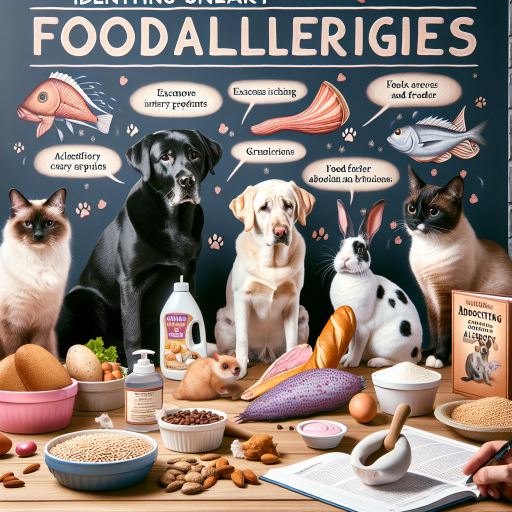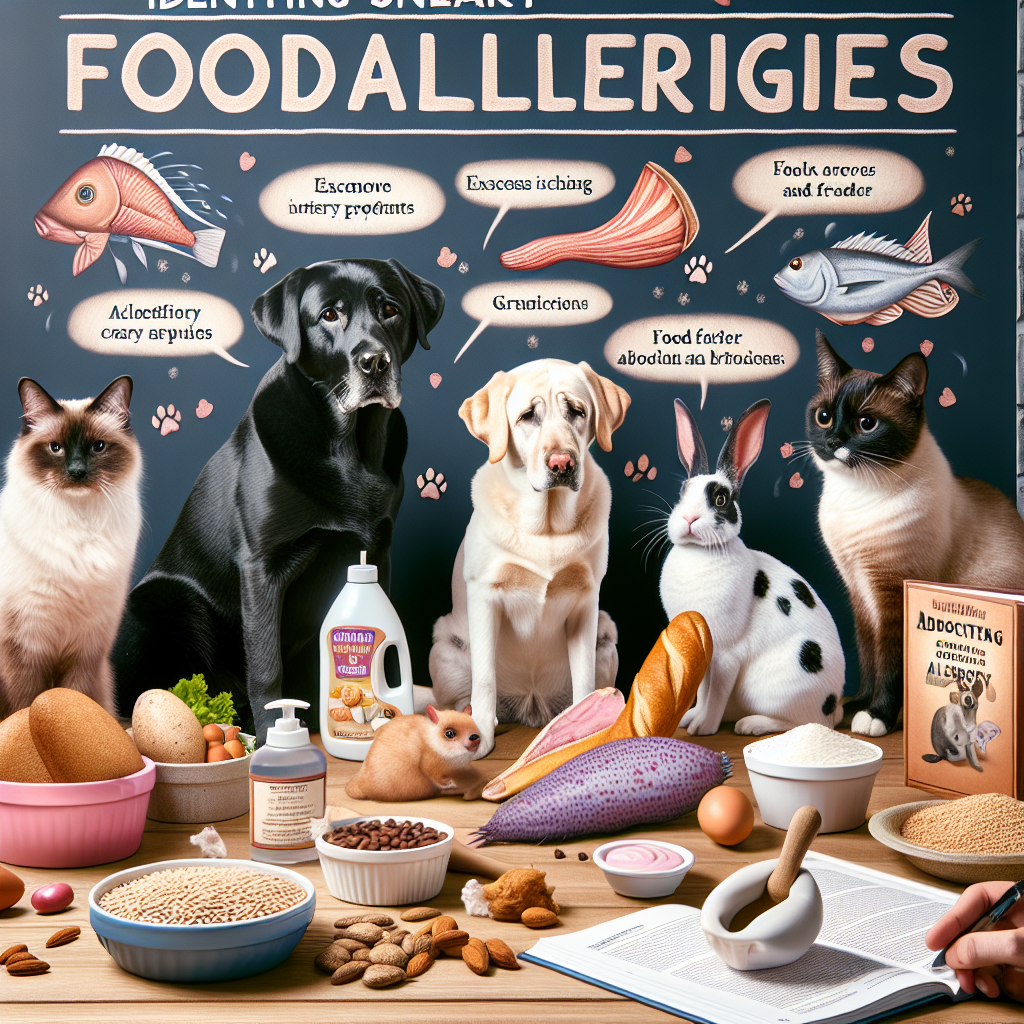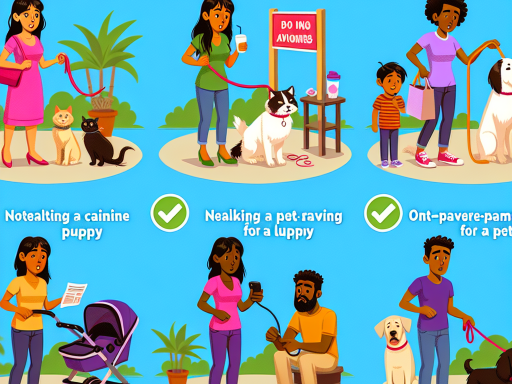Food allergies can be a real challenge for our furry friends, causing discomfort and health issues that can be difficult to pinpoint. Just like humans, pets can develop allergies to certain foods that can have a negative impact on their well-being. In this article, we’ll explore the world of food allergies in pets, from common symptoms to the importance of identifying sneaky allergies that may go unnoticed. Let’s dive in and learn more about how to keep our pets happy and healthy by understanding and managing their food allergies.
Common Symptoms of Food Allergies in Pets
Have you ever noticed your furry friend scratching excessively, experiencing gastrointestinal upset, or showing signs of skin irritation? These could be signs of food allergies in pets. Just like humans, our beloved companions can develop allergies to certain foods, causing discomfort and distress.
Here are some common symptoms to watch out for:
- Itchy Skin: One of the most common signs of food allergies in pets is itching. If your pet is constantly scratching, licking, or biting at their skin, it could be due to an allergic reaction to something in their food.
- Gastrointestinal Upset: If your pet is experiencing frequent diarrhea, vomiting, or flatulence, it could be a sign of a food allergy. Keep an eye on their bowel movements and consult your veterinarian if you notice any unusual changes.
- Ear Infections: Pets with food allergies may also develop ear infections. If your pet is shaking their head, scratching at their ears, or has a foul odor coming from their ears, it could be a sign of an allergic reaction.
- Skin Irritation: Redness, swelling, or rashes on your pet’s skin could be a sign of a food allergy. Keep an eye out for any changes in their skin condition and consult your vet if you notice any abnormalities.
It’s important to remember that food allergies in pets can manifest in different ways, and not all pets will exhibit the same symptoms. If you notice any of these signs in your furry friend, it’s essential to take action to identify the root cause of their discomfort.
Identifying food allergies in pets can be tricky, as the symptoms can often be mistaken for other health issues. That’s why it’s crucial to pay close attention to your pet’s behavior and consult with your veterinarian if you suspect they may have a food allergy. By working together with your vet, you can develop a plan to identify and manage your pet’s food allergies, ensuring they live a happy and healthy life.
Importance of Identifying Sneaky Food Allergies
Food allergies in pets can be tricky to identify as they often present with subtle symptoms that may go unnoticed. However, it is crucial to pinpoint these sneaky food allergies to ensure your furry friend’s health and well-being.
Unlike humans, pets cannot communicate their discomfort or allergies verbally, making it a challenge for pet owners to recognize the signs of food allergies. This is why it is essential to pay close attention to any changes in your pet’s behavior, skin, or digestion that could point to a food allergy.
Ignoring or overlooking food allergies in pets can lead to various health issues, such as skin infections, ear infections, gastrointestinal problems, and even chronic inflammation. If left untreated, these allergies can significantly impact your pet’s quality of life and overall health.
Identifying and addressing food allergies in your pet can prevent unnecessary suffering and discomfort. By taking the time to pinpoint the specific allergen causing trouble, you can help your pet live a happy, healthy, and allergy-free life.
Moreover, undiagnosed food allergies can also lead to misdiagnosis of other health conditions, resulting in unnecessary treatments and expenses. By accurately identifying food allergies, you can avoid unnecessary medications or procedures and provide your pet with the appropriate care they need.
Overall, understanding the importance of identifying sneaky food allergies in pets is crucial for their well-being. By being proactive and observant, you can ensure that your pet remains healthy, happy, and allergy-free.
Steps to Identify Food Allergies in Pets
Do you suspect that your furry friend might be suffering from food allergies? Identifying food allergies in pets can be a tricky process, but with the right steps, you can pinpoint the culprit behind your pet’s discomfort. Here are some tips to help you identify food allergies in your beloved companion:
1. Consult Your Veterinarian
Before you start making any changes to your pet’s diet, it’s crucial to consult your veterinarian. Your vet can help rule out other possible causes of your pet’s symptoms and guide you on the best course of action for identifying food allergies. They may recommend tests or procedures to get a clearer picture of your pet’s health.
2. Keep a Food Diary
Keeping a detailed food diary can be incredibly helpful in identifying potential food allergens for your pet. Note down everything your pet eats, including treats and table scraps. Also, make sure to jot down any symptoms your pet experiences, such as itching, vomiting, diarrhea, or skin rashes. This information can provide valuable insights into which ingredients may be causing your pet’s allergic reactions.
3. Implement an Elimination Diet
An elimination diet involves feeding your pet a novel protein and carbohydrate source that they have never consumed before. This could be something like venison and sweet potato. By eliminating common allergens like chicken, beef, or grains from your pet’s diet, you can slowly reintroduce these ingredients one by one to pinpoint which ones trigger allergic reactions. Remember to consult your vet before starting an elimination diet to ensure it’s done safely and effectively.
4. Monitor Your Pet’s Response
Once you have identified potential allergens through the elimination diet, it’s essential to closely monitor your pet’s response when reintroducing those ingredients. Look out for any signs of allergic reactions such as itching, redness, swelling, or gastrointestinal issues. If your pet displays any adverse reactions, remove that ingredient from their diet and consult your vet for further guidance.
5. Seek Veterinary Consultation
If you suspect that your pet has food allergies but are unsure how to proceed, don’t hesitate to seek veterinary consultation. Your vet can provide valuable insights, perform diagnostic tests, and recommend the best course of action for managing your pet’s allergies. They may also suggest specialized diets or allergy testing to pinpoint specific allergens.
Identifying food allergies in pets can be a challenging process, but with patience, diligence, and the guidance of your veterinarian, you can help your furry friend lead a happy, healthy life free from allergic reactions. Remember that every pet is unique, so what works for one may not work for another. Stay observant, proactive, and always prioritize your pet’s well-being when addressing food allergies.
Keeping a Food Diary for Pets
One of the most effective ways to identify food allergies in your pet is by keeping a detailed food diary. Just like with humans, pets can have different reactions to various foods, so it’s important to track what they’re eating and how they’re responding to it.
Start by recording everything your pet consumes, including their regular meals, treats, and any table scraps they may have snuck. Note down the brand, ingredients, and portion sizes of each item. Keep track of any symptoms or reactions your pet experiences after eating, such as itching, vomiting, diarrhea, or changes in behavior.
By maintaining a food diary, you’ll be able to spot patterns and identify potential triggers for your pet’s food allergies. This can help you work with your veterinarian to determine which ingredients may be causing the allergic reactions.
Here are some tips for keeping a food diary for your pet:
- Use a notebook or a dedicated app to record your pet’s meals and any symptoms they experience.
- Be consistent and thorough in your record-keeping, noting down even small treats or snacks.
- Include details such as the time of day your pet eats, the environment they’re in, and any other factors that may influence their reactions.
- Keep track of any changes in your pet’s overall health and behavior, as food allergies can sometimes manifest as more than just digestive issues.
Remember, it’s essential to be patient and diligent when keeping a food diary for your pet. It may take some time to identify the specific food allergens that are causing problems, but the information you gather will be invaluable in helping your veterinarian develop a suitable treatment plan.
Consulting with a veterinarian is crucial in determining the best course of action for managing your pet’s food allergies. They can provide guidance on conducting elimination diets, allergy testing, and other diagnostic measures to pinpoint the root cause of your pet’s allergic reactions.
Elimination Diet for Pets
So, you suspect that your furry friend may have a food allergy. What’s the next step? Well, one of the most effective ways to pinpoint the culprit behind your pet’s allergic reactions is to put them on an elimination diet.
An elimination diet is like playing detective – you slowly remove potential allergens from your pet’s diet to see which one is causing the problem. It may sound a bit daunting at first, but trust me, it’s not as complicated as it seems.
Here’s how you can start:
- Consult Your Veterinarian: Before starting an elimination diet, it’s crucial to consult your vet. They can guide you on the best approach to take and ensure your pet’s nutritional needs are still being met.
- Choose a Novel Protein and Carbohydrate Source: The key to an elimination diet is to feed your pet proteins and carbohydrates that they have never been exposed to before. This can be something like venison or duck for protein, and sweet potatoes or peas for carbohydrates.
- Stick to the Plan: It’s essential to be strict during the elimination period. This means no treats, no table scraps, and absolutely no cheating. You want to give your pet’s system time to reset and identify the allergen.
- Gradually Reintroduce Foods: After a few weeks on the elimination diet and once your pet’s symptoms have cleared up, you can start reintroducing foods one at a time. This will help you determine which specific ingredient is causing the allergic reaction.
- Monitor Your Pet: Throughout this process, keep a close eye on your pet’s symptoms. Note any changes or reactions as you reintroduce different foods. This will help you pinpoint the exact allergen more quickly.
Remember, patience is key when it comes to an elimination diet. It can take time to see results, but it’s worth it in the end to give your pet relief from their allergic reactions.
If you find that the elimination diet is not helping or if your pet’s symptoms worsen, don’t hesitate to reach out to your vet for further guidance. They may recommend allergy testing or other diagnostic tools to help identify the allergen.
In the meantime, enjoy the detective work of figuring out what’s been causing your pet’s discomfort. With a little bit of patience and perseverance, you’ll be able to help your furry friend live a happier, healthier, and allergy-free life.
Seeking Veterinary Consultation
When it comes to identifying and treating food allergies in your beloved pets, seeking veterinary consultation is crucial. Your veterinarian is a trained professional who can help you navigate through the process of determining your pet’s food allergies and finding the right solution.
Here are some reasons why consulting with a veterinarian is important:
- Expertise: Veterinarians have the knowledge and expertise to properly diagnose food allergies in pets. They can conduct tests and examinations to pinpoint the specific allergen causing your pet’s symptoms.
- Customized Treatment Plan: A veterinarian can create a customized treatment plan tailored to your pet’s specific needs. This may include recommending a hypoallergenic diet, prescribing medications, or suggesting alternative options to manage your pet’s food allergies.
- Prevent Complications: Food allergies in pets can lead to various complications if left untreated. Consulting with a veterinarian can help prevent these complications and ensure your pet’s overall health and well-being.
- Professional Guidance: Your veterinarian can provide you with professional guidance on how to manage your pet’s food allergies effectively. They can offer valuable advice on feeding practices, environmental factors, and other important considerations to keep your pet healthy.
Remember, your pet’s health is precious, and it’s essential to seek professional help when dealing with food allergies. Your veterinarian is there to support you and your furry companion every step of the way.
Don’t hesitate to schedule an appointment with your veterinarian if you suspect that your pet may have food allergies. They can help you determine the best course of action to ensure your pet’s comfort and well-being.
By working together with your veterinarian, you can effectively manage your pet’s food allergies and provide them with the care and attention they deserve. Your veterinarian is your ally in keeping your pet healthy and happy, so don’t hesitate to reach out for help.





